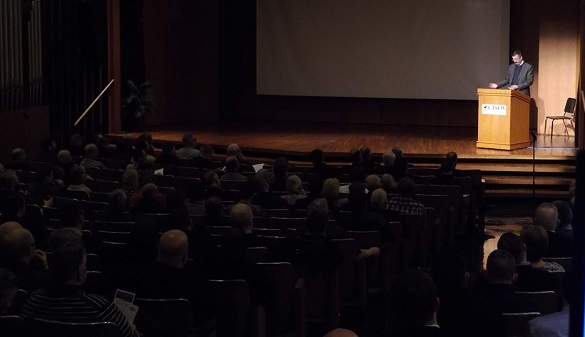
Symposia opened with Dr. Jeffrey Pulse, Associate Professor of Exegetical Theology here at CTSFW, on “Substitutionary Atonement in the Joseph Narratives.” He began by defining substitutionary atonement: Christ’s death in our place. Such a definition properly excludes the work of man and his participation in the event. It is the complete and exclusive work of Christ on our behalf. This is of immense importance. In the words of Martin Luther: “If the sins of the entire world were on that one man, Jesus Christ, then they are not on the world.”
Articulating this doctrine isn’t difficult. Simply turn to Scripture and see substitutionary atonement throughout its pages. Dr. Pulse explains that you should approach the text, from Genesis to Revelation, as a unified theological narrative. Selective readings can cause you to lose the message. In other words, the grand narrative is to be read as not only unified in one story, it’s also to be understood and read as unified in theology as well. The Israelites, the early church fathers, and Martin Luther all taught that these writings were to be read and understood as a whole. They represent a unified message from God.
The Bible is, admittedly, very long—impossible to read in a single sitting. As such, to keep a handle on this understanding of the Bible as a unified narrative, Dr. Pulse teaches that you should pay attention to the motifs interwoven throughout. A motif is a recurring thematic element (or a dominant idea or central theme), and the Bible is woven as a tapestry from the many, many motifs that serves as its threads. Themes like clothing/being clothed, garden/trees, and substitutionary atonement.
Substitutionary atonement makes its first appearance early on, when Adam and Eve are ejected from the Garden of Eden and God immediately binds Himself to a covenant in which the seed of the woman will crush the head of Satan. Man can do nothing to remove the sin that prevents his reunion with God—and so the coming Messiah will take man’s place, by paying the price of His holy blood and undeserved death.
The institution of the Day of Atonement (Yom Kippur) in Leviticus is another instance of the occurrence of this motif. It’s not a day of feasting or a festival, but is instead a fast in which the high priest stands in place of—as a substitute—in place of the people. As sole celebrant, he acts on behalf of the people.
Motifs are made up of multiple examples, woven throughout Scripture. The Bible was not written as a dogmatic theological text, but as a unified narrative. If we approach the Word of God in such a manner, we’ll avoid the dangers of proof texting, taking passages out of context, etc. When we fall into the trap of reading only portions of God’s word to develop theology that are palatable to our culture and/or world view, we end up with manmade, culturally sensitive dogma. God becomes a merciless judge, or guilty of divine child abuse; substitutionary atonement is accused of being immoral. But these criticisms are shallow—little more than people saying, “I don’t like this doctrine.”
This is only a piece of the full lecture, which was about 50 minutes long and focused the motif of Substitutionary Atonement on the Joseph narratives in Genesis (like Judah offering to substitute himself in the place of Benjamin near the end of the story). To watch this lecture (and the rest of Symposia) in full, you can purchase livestream access at www.ctsfw.edu/symposia-live. The 2020 Symposia lectures will eventually be available and open to all at no cost on our video site in about 6-9 months.
